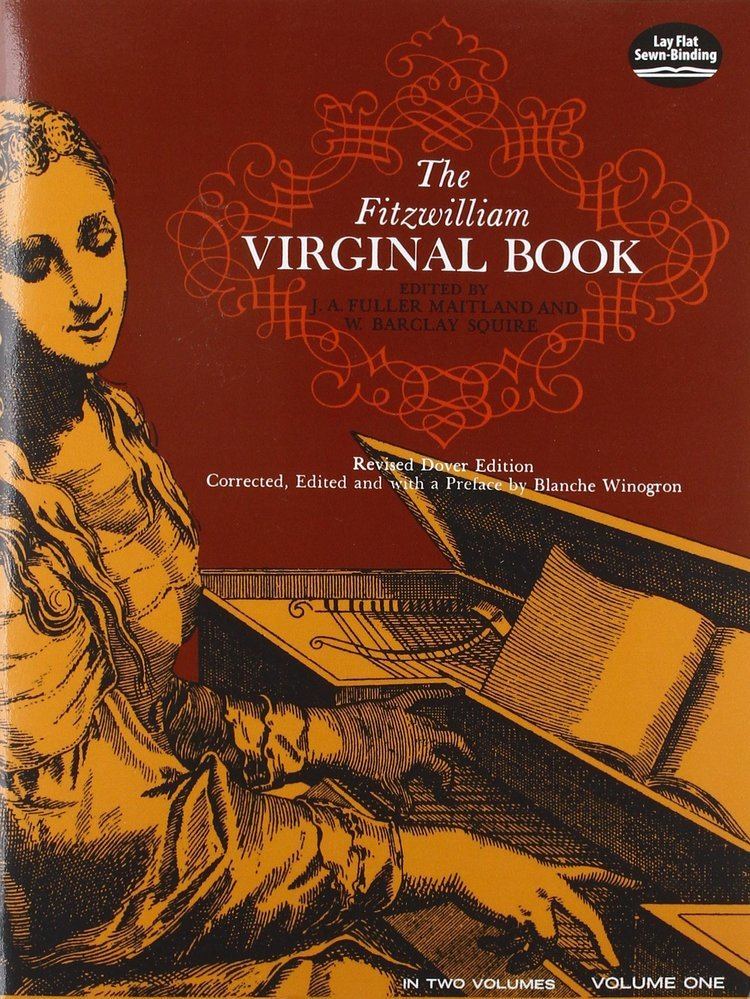10 /10 1 Votes10
| 5/5 Amazon | |||||||||||||||||||||||||||||||||
 | ||||||||||||||||||||||||||||||||||
Editors William Barclay Squire, John Alexander Fuller Maitland Similar My Ladye Nevells Booke, The Dancing Master, The Triumphs of Oriana, A plaine and easie introducti, My Ladye Nevells Booke of | ||||||||||||||||||||||||||||||||||
Fitzwilliam virginal book alman anon martha cook harpsichord
The Fitzwilliam Virginal Book is a primary source of keyboard music from the late Elizabethan and early Jacobean periods in England, i.e., the late Renaissance and very early Baroque. It takes its name from Viscount Fitzwilliam who bequeathed this manuscript collection to Cambridge University in 1816. It is now deposited in the Fitzwilliam Museum at Cambridge. Although the word virginals or virginal (the plural form does not necessarily denote more than one instrument) is used today to refer to a specific instrument similar to a small, portable harpsichord, at the time of the book the word was used to denote virtually any keyboard instrument including the organ.
Contents
- Fitzwilliam virginal book alman anon martha cook harpsichord
- Orlando gibbons pavana from the fitzwilliam virginal book
- History
- The Pieces in the Book
- John Munday
- Thomas Morley
- References
Orlando gibbons pavana from the fitzwilliam virginal book
History
It was given no title by its copyist and the ownership of the manuscript before the eighteenth century is unclear. At the time the Fitzwilliam Virginal Book was put together most collections of keyboard music were compiled by performers: other examples include Will Forster's Virginal Book, Clement Matchett's Virginal Book, and Anne Cromwell's Virginal Book. Until Parthenia was printed in about 1612, there was no keyboard music published as such in England, because of the technical complexity of printing keyboard music as opposed to, for example, vocal parts.
It was once called Queen Elizabeth's Virginal Book, a title that has been abandoned because it has been determined that she never owned it, Another hypothesis, which still has supporters, is that it belonged to Francis Tregian the Younger, a recusant and amateur musician. It has been argued that Tregian may have copied the entire collection while imprisoned in the period leading up to his death in 1618. The nature of Tregian's contribution to the book, if any, has been disputed. Recent scholarship suggests that even if Tregian is the compiler, it is unlikely that he was imprisoned long enough to do the copying involved.
It includes music dating from approximately 1562 to 1612 by John Bull, William Byrd, Orlando Gibbons, Giles Farnaby (51 of whose 52 known pieces are included), Martin Peerson, Peter Philips and Jan Pieterszoon Sweelinck, as well as many others. There are 297 separate pieces (actually, 298: one piece is numbered, but is blank. Strangely, the Maitland Squire edition numbers No. 182 twice). As with many keyboard manuscripts of the time, the pieces were not written for a specific instrument, and most sound happily on all contemporary keyboard instruments, including virginals, harpsichord, clavichord and chamber organ. Many of the pieces in the book are short, and many of them are character pieces with droll and memorable titles, including "Put Up Thy Dagger, Jemy", "The New Sa-Hoo", and "Quodlings Delight" by Giles Farnaby; "Nobody's Gigge", by Richard Farnaby; "Pakington's Pownde" and "The Irishe Dumpe" (anonymous); "The Ghost" and "The Earle of Oxford's Marche" by William Byrd; "Worster Braules" by Thomas Tomkins; and the famous "Lachrymae Pavan" by John Dowland, as arranged by Giles Farnaby and by William Byrd.
In 1899, Breitkopf & Härtel published an edition in two volumes (the Maitland Squire edition, see the Sources below) with only a basic critical commentary, which has been reprinted by Dover Publications and is available inexpensively. A microfilm facsimile of the manuscript is included in The music collections of the Cambridge libraries (Woodbridge, Conn. : Research Publications, 1991). Musica Britannica is preparing a volume dedicated to the "Keyboard Music from Fitzwilliam Manuscripts" [1].
Richard Strauss used several selections from the Fitzwilliam Virginal Book in his 1935 opera, Die schweigsame Frau, and cited them accordingly at their appearances in the work. They appear at ritualized moments in the action to provide commentary and atmosphere in the Act 2 marriage scene (No. XIV and No. XC) and in the Act 3 courtroom scene (No. XXXVII).
The first recording of selections from the anthology was made by Joseph Payne in 1964. It was issued by Vox Box (i.e. Vox Records) as a three-LP boxed set and features Payne performing three album sides on harpsichord (a modern Eric Herz instrument) and three sides on organ. Generally the more moderately paced and sustained pieces are performed on the organ.
The Pieces in the Book
(For each composer, the pieces follow the order in which they appear in the manuscript)
